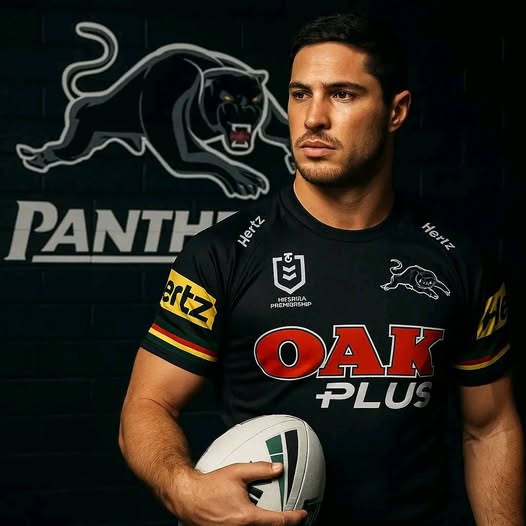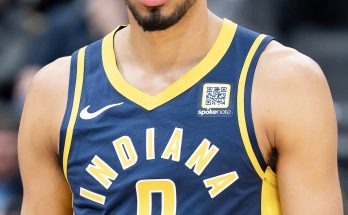In a move that has rocked the National Rugby League to its core, Mitchell Moses has officially signed a jaw-dropping $7 million contract with the Penrith Panthers, leaving behind the Parramatta Eels in one of the most stunning transfers in recent memory. The bombshell deal, confirmed late Friday afternoon, sends shockwaves across the league and marks a significant power shift in the NRL landscape.
The 29-year-old playmaker, long seen as the cornerstone of the Eels’ premiership ambitions, has opted to join their fiercest rivals, in what many are calling the most controversial and impactful player movement since the dawn of the modern NRL era. The Panthers, already a dominant force with multiple recent premierships under their belt, now add another elite weapon to an already star-studded roster.
Sources close to the negotiations suggest Moses’ new deal is worth approximately $7 million over five years, making him one of the highest-paid players in the history of the competition. This contract not only underlines Penrith’s determination to remain at the top of the NRL mountain, but also signals the dawn of a new era for both clubs involved.
For Parramatta fans, the news will be nothing short of devastating. Moses has been the heartbeat of the Eels since his arrival in 2017, known for his exceptional kicking game, electric speed, and ability to control the tempo of matches. His leadership and flair helped guide the Eels to a Grand Final appearance in 2022 and made him a fan favorite at CommBank Stadium. While rumors had swirled about interest from rival clubs, few expected him to walk away — and even fewer predicted he would land at the doorstep of their western Sydney nemesis.
Penrith, on the other hand, has pulled off what can only be described as a masterstroke. The Panthers have established themselves as the NRL’s gold standard in recent years, combining homegrown talent with elite-level coaching under Ivan Cleary. The addition of Moses only enhances their already lethal spine and provides a contingency plan for the possible long-term departure or injury to current playmakers. Moses’ experience, composure, and proven ability to win games in crunch time could be the missing piece in keeping the Panthers’ dynasty alive well into the next decade.
Club officials from both Penrith and Parramatta have yet to hold official press conferences, but early statements from insiders suggest Moses made the decision based on his desire to win premierships and play in a system tailored to maximize his strengths. While the Eels have remained competitive, their inability to break through consistently in the finals may have factored into the star halfback’s reasoning.
“He’s made a decision that he believes is best for his career and future,” one source close to Moses told reporters. “It’s not about money — it’s about legacy, opportunity, and being part of something truly special.”
Despite that sentiment, financial terms have also become a point of fierce discussion. The $7 million figure places Moses among the richest earners in league history and shows just how far clubs are willing to go to secure marquee talent. In the salary-cap era, such bold spending is both a risk and a reward. Penrith’s front office clearly believes that Moses’ talent and experience justify the investment.
The move also ignites a fierce debate about loyalty in modern sport. Parramatta was said to have tabled a highly competitive offer of their own — rumored to be in the $6 million range — and were confident they had done enough to retain their star man. Moses had publicly indicated his happiness with life at the Eels, frequently expressing his affection for the club and its passionate supporter base. His sudden exit will inevitably lead to questions about the timing of the decision and whether the writing had been on the wall for longer than previously assumed.
NRL analysts have already begun dissecting the ramifications of the transfer. Some view it as a potential death knell for the Eels’ premiership hopes in the near future, while others believe the club can pivot and use the freed-up cap space to retool their squad with younger, hungrier talent. For the Panthers, this acquisition might only widen the gap between them and the rest of the league, especially if Moses finds immediate synergy with their backline and coaching staff.
The cultural impact of the move cannot be understated. Western Sydney has long been a battleground for rugby league supremacy, with the Eels and Panthers representing two of the most passionate and loyal fan bases in the game. The rivalry, already fierce, is now set to reach volcanic levels. Expect fireworks when the two sides meet on the field, with Moses likely to be the target of boos, jeers, and intense media scrutiny. The pressure will be immense, but if there’s one player with the temperament and confidence to handle it, it’s Moses.
It’s not the first time Moses has made a controversial switch. In 2017, he left the Wests Tigers mid-season to join the Eels — a decision that also drew heavy criticism at the time. But he silenced the doubters with his performances and commitment, eventually becoming one of the game’s elite halves. Now, he’ll face that same skepticism again — perhaps even more intensely — as he dons the black jersey of the Panthers and tries to write a new chapter in his storied career.
Beyond the field, the transfer may also have broader implications for the business of rugby league. It sets a new benchmark for what star players can command on the open market and raises questions about how clubs will manage their salary cap going forward. With younger players increasingly aware of their market value and more teams willing to spend big to secure success, the NRL may soon see a more aggressive era of player movement and mega-deals.
In response to the news, social media exploded with reactions ranging from disbelief to celebration. Penrith fans flooded platforms like X and Instagram with memes, welcome messages, and bold predictions of continued dominance. Eels supporters, meanwhile, voiced heartbreak and outrage, with many questioning the loyalty of their former talisman. Several ex-players and pundits also weighed in, with some praising the boldness of the move and others expressing concern about the message it sends to fans and young players.
For Moses himself, the next few weeks will be critical. He’ll need to quickly integrate into a new locker room, adapt to a different playbook, and win over a new fan base — all while blocking out the noise from critics and former supporters. But if his past has shown anything, it’s that he thrives under pressure and often plays his best football when the stakes are highest.
The Panthers, for their part, now find themselves in an enviable position. With Moses joining a spine that already includes some of the most dangerous attacking weapons in the league, they are poised to remain the NRL’s top dog for years to come. The pressure to deliver will increase, but so too will the expectations of greatness.
Meanwhile, Parramatta must regroup. The loss of Moses is a major blow, both from a tactical and emotional standpoint. The Eels have invested years into building a team around their No. 7, and now find themselves in need of a new direction. Whether that comes from promoting young talent, exploring the transfer market, or recalibrating their playing style remains to be seen.
In the end, Mitchell Moses’ $7 million move to the Penrith Panthers will be remembered as one of the most seismic shifts in NRL history. It changes not only the future of two of the league’s biggest clubs, but potentially alters the competitive balance of the entire competition. As fans, players, and pundits alike come to terms with the reality of this extraordinary transfer, one thing is clear — the NRL will never be quite the same again.



